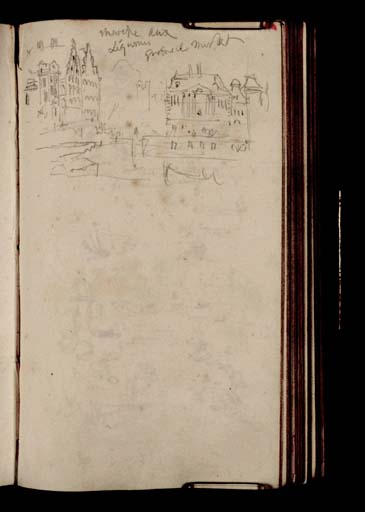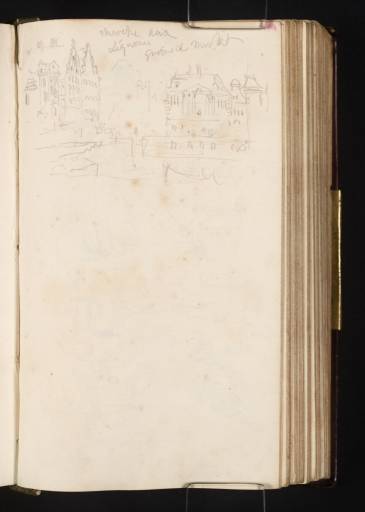Joseph Mallord William Turner The Vleehuisbrug on the River Leie, Ghent, from the Groentenmarkt, with the Gatehouse of the Gravensteen beyond Houses along the Kleine Vismarkt 1825
Image 1 of 2
-
 Joseph Mallord William Turner, The Vleehuisbrug on the River Leie, Ghent, from the Groentenmarkt, with the Gatehouse of the Gravensteen beyond Houses along the Kleine Vismarkt 1825
Joseph Mallord William Turner, The Vleehuisbrug on the River Leie, Ghent, from the Groentenmarkt, with the Gatehouse of the Gravensteen beyond Houses along the Kleine Vismarkt 1825 -
 Joseph Mallord William Turner, The Vleehuisbrug on the River Leie, Ghent, from the Groentenmarkt, with the Gatehouse of the Gravensteen beyond Houses along the Kleine Vismarkt 1825 (Enhanced image)Enhanced image
Joseph Mallord William Turner, The Vleehuisbrug on the River Leie, Ghent, from the Groentenmarkt, with the Gatehouse of the Gravensteen beyond Houses along the Kleine Vismarkt 1825 (Enhanced image)Enhanced image
Joseph Mallord William Turner,
The Vleehuisbrug on the River Leie, Ghent, from the Groentenmarkt, with the Gatehouse of the Gravensteen beyond Houses along the Kleine Vismarkt
1825
Joseph Mallord William Turner 1775–1851
Folio 201 Verso:
The Vleehuisbrug on the River Leie, Ghent, from the Groentenmarkt, with the Gatehouse of the Gravensteen beyond Houses along the Kleine Vismarkt 1825
D19239
Turner Bequest CCXIV 201a
Turner Bequest CCXIV 201a
Pencil on white wove paper, 155 x 95 mm
Inscribed by Turner in pencil ‘Marche aux | Légumes | Groensel Markt’ top centre
Inscribed by Turner in pencil ‘Marche aux | Légumes | Groensel Markt’ top centre
Accepted by the nation as part of the Turner Bequest 1856
References
1909
A.J. Finberg, A Complete Inventory of the Drawings of the Turner Bequest, London 1909, vol.II, p.658, CCXIV 201a, as ‘“Marche aux Légumes – Groensel Markt.”’.
With the page inverted relative to the sketchbook’s foliation, the view is to the north-north-west over the Vleehuisbrug (since replaced) on the River Leie in Ghent, towards the outline of the Gravensteen fortress in the distance. The elaborate gabled façades towards the left survive along the Kleine Vismarkt, and the building with the pediment and hipped roof still overlooks the river. Turner’s bilingual notes above refer to the Groentenmarkt (vegetable market), his viewpoint as seen in the foreground on folio 202 recto opposite (D19240), and were likely taken from adjacent signage. There is a closer view of the Gravensteen on the other page; elements there and on this page correspond with a detailed 1840s drawing by William Callow, Vegetable Market, Ghent (Tate A00149). In 1850, Callow made another looking back in this direction, Place St Pharailde, Ghent (A00148).
The city, locally ‘Gent’ (or ‘Gand’ in the French sometimes used on older maps and in Turner’s notes), is situated in the Dutch-speaking Flemish region of modern Belgium (generally ‘Flanders’ in English), at that time part of the post-Napoleonic United Kingdom of the Netherlands. These pages are the first in a sequence around the city, about thirty-five miles by coach1 west-south-west from Antwerp (see under folio 188 recto (D19212), the last view of which is on the recto (D19238).
Ghent was historically a major centre for wool and textiles, as reflected in its prosperous medieval and Renaissance houses and churches. The city centre stands within and around the River Leie, flowing clockwise north, east and south in a rough U-shape, meeting other waterways here and there before flowing into the River Scheldt a mile or so to the south-east. Today, the city is perhaps most readily associated culturally with the complex early fifteenth-century Adoration of the Mystic Lamb altarpiece by the van Eyck brothers housed in the cathedral. At the time, after various travails in recent decades, few if any of the panels would have been on view there,2 and there is no sign from his sketches that Turner entered the cathedral or the other impressive churches.
Instead, his attention was largely concentrated on views along the Leie and the streets within its loop, with a brief foray southwards to study outlying churches on folio 204 recto (D19244). See also folios 202 verso–207 recto and 209 recto–212 recto, and possibly 213 recto (D19241–D19250, D19254–D19260, D19262). He had seemingly barely paused in 1817, using the Waterloo and Rhine sketchbook (Tate D12715–D12716; Turner Bequest CLX 8a–9; see under folio 206 recto; D19248); from the previous year, 1824, there is only one positively identified subject in the Rivers Meuse and Moselle sketchbook (D19854; CCXVI 150b), a labelled study of distant church towers, with a few subsequent sketches possibly made around the city.
Turner passed through again in 1833, and the Brussels up to Mannheim – Rhine sketchbook contains several views (Tate D29596, D29614–D29619; CCXCVI 1a, CCXCVI 9a–12), some of which have their equivalents here, as noted in individual entries. Tate also holds another pencil drawings by Callow (Tate A00154); see under folio 203 verso (D19243). From Ghent, Turner travelled on to Bruges (see under folio 218 recto; D19272), about twenty-four miles to the north-west as the crow flies. He likely used one of the regular, flamboyantly appointed passenger barges along the twenty-eight miles of the Ghent-Bruges canal (the Kanaal Gent-Brugge), as discussed under his sketches of one on folio 214 recto (D19264).
Matthew Imms and Quirine van der Meer Mohr
September 2020
How to cite
Matthew Imms and Quirine van der Meer Mohr, ‘The Vleehuisbrug on the River Leie, Ghent, from the Groentenmarkt, with the Gatehouse of the Gravensteen beyond Houses along the Kleine Vismarkt 1825 by Joseph Mallord William Turner’, catalogue entry, September 2020, in David Blayney Brown (ed.), J.M.W. Turner: Sketchbooks, Drawings and Watercolours, Tate Research Publication, March 2023, https://www

